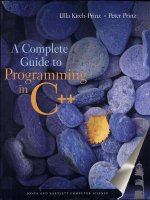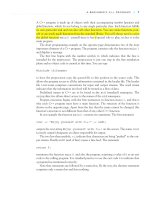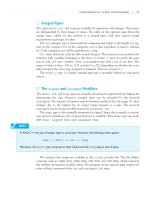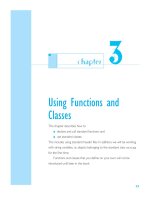A Complete Guide to Programming in C++ part 18 pot
Bạn đang xem bản rút gọn của tài liệu. Xem và tải ngay bản đầy đủ của tài liệu tại đây (202.99 KB, 10 trang )
EXERCISES
■
149
1. Plot one point of the curve in columns 10, 10+1, , 10+64 respectively. This leads to a
step value of 2*PI/64 for x.
2. Use the following extended ASCII code characters to draw the axes:
Example:
cout << '\020'; // up arrowhead
✓
NOTE
Character Decimal Octal
–
+
196
197
16
30
304
305
020
036
Exercise 1
A function has the following prototype
void func( unsigned int n);
What happens when the function is called with –1 as an argument?
Exercise 2
How often is the following loop executed?
unsigned int limit = 1000;
for (int i = –1; i < limit; i++)
// . . .
Exercise 3
What is output when the program opposite is executed?
Exercise 4
Write a C++ program to output the sine curve on screen as in the graphic
shown on the opposite page.
solutions
150
■
CHAPTER 8 CONVERTING ARITHMETIC TYPES
■
SOLUTIONS
Exercise 1
When called, the value –1 is converted to parameter n, i.e. to unsigned int.
The pattern of
–1 is interpreted as unsigned, which yields the greatest unsigned
value.
On a 32-bit system,
–1 has the bit pattern 0xFFFFFFFF, which, when
interpreted as unsigned, corresponds to the decimal value 4 294 967 295.
Exercise 2
The statement within the loop is not executed at all! In the expression
i < limit
the value of variable i, –1, is implicitly converted to unsigned int and thus it
represents the greatest
unsigned value (see Exercise 1).
Exercise 3
The screen output of the program
v_char: A 65
v_short: -2 fffe
v_ushort: 65534 fffe
v_ulong: fffffffe
v_float: -1.99
(int)v_float: -1
Exercise 4
//
// sinCurve.cpp
// Outputs a sine curve
//
#include <iostream>
#include <cmath> // Prototypes of sin()
using namespace std;
#define CLS (cout << "\033[2J")
#define LOCATE(z,s) (cout <<"\033["<<(z)<<';'<<(s)<<'H')
#define PI 3.1415926536
#define START 0.0 // Lower limit
#define END (2.0 * PI) // Upper limit
SOLUTIONS
■
151
#define PNT 64 // Number of points on the curve
#define STEP ((END-START)/PNT)
#define xA 14 // Row of x-axis
#define yA 10 // Column of y-axis
int main()
{
int row, column;
CLS;
LOCATE(2,25);
cout << " The Sine Function ";
// Draws the coordinate system:
LOCATE(xA,1); // x-axis
for( column = 1 ; column < 78 ; ++column)
{
cout << ((column - yA) % 8 ? '\304' : '\305');
}
cout << '\020'; // top
LOCATE(xA-1, yA+64); cout << "2PI x";
for( row = 5 ; row < 24 ; ++row) // y-axis
{
LOCATE(row, yA); cout << '\305';
}
LOCATE( 4, yA); cout << "\036 sin(x)"; // top
LOCATE( xA-8, yA+1); cout << " 1";
LOCATE( xA+8, yA+1); cout << " -1";
// Displays the sine function:
int begpt = yA,
endpt = begpt + PNT;
for( column = begpt ; column <= endpt ; ++column)
{
double x = (column-yA) * STEP;
row = (int)(xA - 8 * sin(x) + 0.5);
LOCATE( row, column); cout << '*';
}
LOCATE(25,1); // Cursor to the last row
return 0;
}
This page intentionally left blank
153
The Standard Class
string
This chapter introduces the standard class string, which is used to
represent strings. Besides defining strings we will also look at the various
methods of string manipulation.These include inserting and erasing,
searching and replacing, comparing, and concatenating strings.
chapter
9
154
■
CHAPTER 9 THE STANDARD CLASS STRING
'G' 'o' 'o' 'o' 'r' 'n' 'n' '!'g''i''d' ' ' 'M'
13
String
literal:
Length:
String message in memory:
// string1.cpp: Using strings
#include <iostream>
#include <string>
using namespace std;
string prompt("Enter a line of text: "), // Global
line( 50, '*'); // strings
int main()
{
string text; // Empty string
cout << line << endl << prompt << endl;
getline( cin, text); // Reads a line of text
cout << line << endl
<< "Your text is " << text.size()
<< " characters long!" << endl;
// Two new strings:
string copy(text), // a copy and the
start(text,0,10); // first 10 characters
// starting with
// position 0.
cout << "Your text:\n" << copy << endl;
text = "1234567890"; // Assignment
cout << line << endl
<< "The first 10 characters:\n" << start << endl
<< text << endl;
return 0;
}
■
DEFINING AND ASSIGNING STRINGS
Initializing
string message = "Good Morning!";
Sample program
Objects of class string do not necessarily contain the string terminating character '\0', as is the case
with C strings.
✓
NOTE
DEFINING AND ASSIGNING STRINGS
■
155
C++ uses the standard class string to represent and manipulate strings allowing for
comfortable and safe string handling. During string operations the required memory
space is automatically reserved or modified. The programmer does not need to concern
himself or herself with internal memory allocation.
The string class is defined in the string header file and was mentioned in Chap-
ter 3 as an example for the use of classes. Several operators are overloaded for strings,
that is, they were also defined for the string class. This allows for easy copying, con-
catenation, and comparison. Additionally, various methods for string manipulation such
as insertion, erasing, searching, and replacing are available.
ᮀ Initializing Strings
A string, that is, an object belonging to the string class, can be initialized when you
define it using
■ a predefined string constant
■ a certain number of characters
■ a predefined string or part of a string.
If a string is not initialized explicitly, an empty string with a length of 0 is created.
The length of a string, that is, the current number of characters in the string, is stored
internally and can be accessed using the length() method or its equivalent size().
Example: string message("Good morning!");
cout << message.length(); // Output: 13
ᮀ String Assignments
When you assign a value to a string, the current contents are replaced by a new character
sequence. You can assign the following to a string object:
■ another string
■ a string constant or
■ a single character.
The memory space required is adjusted automatically.
The program on the opposite page uses the function getline(), which was intro-
duced in an earlier chapter, to store a line of text from the keyboard in a string. In con-
trast, the >> operator reads only one word, ignoring any leading white space. In both
cases the original content of the string is lost.
156
■
CHAPTER 9 THE STANDARD CLASS STRING
// string2.cpp: Reads several lines of text and
// outputs in reverse order.
#include <iostream>
#include <string>
using namespace std;
string prompt("Please enter some text!\n"),
line( 50, '-');
int main()
{
prompt+="Terminate the input with an empty line.\n ";
cout << line << '\n' << prompt << line << endl;
string text, line; // Empty strings
while( true)
{
getline( cin, line); // Reads a line of text
if( line.length() == 0) // Empty line?
break; // Yes ->end of the loop
text = line + '\n' + text; // Inserts a new
// line at the beginning.
}
// Output:
cout << line << '\n'
<< "Your lines of text in reverse order:"
<< '\n' << line << endl;
cout << text << endl;
return 0;
}
■
CONCATENATING STRINGS
Sample program
Sample output for this program
Please enter some text!
Terminate the input with an empty line.
Babara, Bobby, and Susan
will go to the movies today
Your lines of text in reverse order:
will go to the movies today
Babara, Bobby, and Susan
CONCATENATING STRINGS
■
157
At least one operand must be a string class object. The expression "Good morning " +
"mister X" would be invalid!
✓
NOTE
Within the string class the operators + and += are defined for concatenating, and the
operators ==, !=, <, <=, >, and >= are defined for comparing strings. Although these
operators are being applied to strings, the well-known rules apply: the + has precedence
over the comparative operators, and these in turn have higher precedence than the
assignment operators = and +=.
ᮀ Using + to Concatenate Strings
You can use the + operator to concatenate strings, that is, to join those strings together.
Example: string sum, s1("sun"), s2("flower");
sum = s2 + s3;
This example concatenates the strings s1 and s2. The result, "sunflower" is then
assigned to sum.
Two strings concatenated using the + operator will form an expression of the string
type. This expression can in turn be used as an operand in a more complex expression.
Example: string s1("sun"),s2("flower"),s3("seed");
cout << s1 + s2 + s3;
Since the + operator has precedence over the << operator, the strings are concatenated
before the “sum” is output. Concatenation takes place from left to right. String constants
and single characters are also valid as operands in expressions containing strings:
Example: string s("Good morning ");
cout << s + "mister X" + '!';
ᮀ Using += to Concatenate Strings
Strings can also be concatenated by first performing concatenation and then assigning
the result.
Example: string s1("Good "),s2("luck!");
s1 = s1 + s2; // To concatenate s2 and s1
This example creates a temporary object as a result of s1 + s2 and then assigns the
result to s1. However, you can obtain the same result using the assignment operator += ,
which is far more efficient.
Example: s1 += s2; // To concatenate s2 and s1.
s1 += "luck!"; // Also possible
This adds the content of the second string directly to s1. Thus, the += operator is prefer-
able to a combination of the
+ and = operators.
158
■
CHAPTER 9 THE STANDARD CLASS STRING
// string3.cpp: Inputs and compares lines of text.
#include <iostream>
#include <string>
using namespace std;
string prompt = "Please enter two lines of text!\n",
line( 30, '-');
int main()
{
string line1, line2, key = "y";
while( key == "y" || key == "Y")
{
cout << line << '\n' << prompt << line << endl;
getline( cin, line1); // Read the first
getline( cin, line2); // and second line.
if( line1 == line2)
cout << " Both lines are the same!" << endl;
else
{
cout << "The smaller line is:\n\t";
cout << (line1 < line2 ? line1 : line2)
<< endl;
int len1 = line1.length(),
len2 = line2.length();
if( len1 == len2)
cout << "Both lines have the same length! \n";
else
{ cout << "The shorter line is:\n\t";
cout << (len1 < len2 ? line1 : line2)
<< endl;
}
}
cout << "\nRepeat? (y/n) ";
do
getline( cin, key);
while( key != "y" && key != "Y"
&& key != "n" && key != "N");
}
return 0;
}
The relational operators yield the desired result for strings only if at least one operand is an object of
class string. See Chapter 17, Pointers and Arrays, for more information.
✓
NOTE
■
COMPARING STRINGS
Sample program









